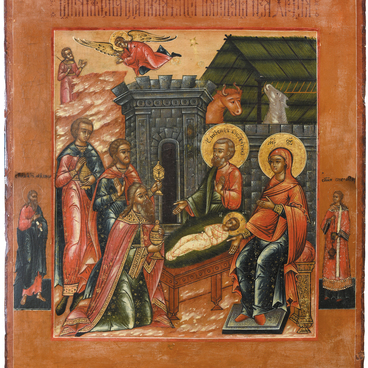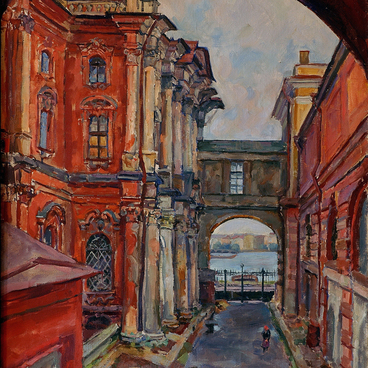The Meeting of the Lord is one of the most significant Christian feasts. It is dedicated to the day when the Mother of God brought the Infant Christ to the Temple in Jerusalem. According to Jewish written law of that time, each firstborn at 40 days old was to undergo the ceremony of dedication to God. In Jerusalem, the Virgin Mary, her husband Joseph and the Infant were met by Anna the Prophetess and Simeon the God-receiver. For that reason, the feast is translated from Old Church Slavonic as the ‘meeting’.
The Meeting of the Lord
Время создания
Late 17th century. North-Western region
Размер
70,5x52 cm
70.5х52х3.5 cm
70.5х52х3.5 cm
Техника
Wood (board of three parts, hollowed out), two inset cross-splines. Canvas, gresso, tempera, gilding and silvering
Выставка
0
Открыть в приложении#3
Unknown Author
The Meeting of the Lord
#2
#5
One of the mosaics on the Triumphal Arch in the Church of Santa Maria Maggiore in Rome. Source: commons.wikimedia.org
The oldest mosaic image of the Meeting appeared in the 5th century. It is located in the Triumphal Arch in the Roman Church of Santa Maria Maggiore. In Russia, the feast was first depicted in the 12th century in frescoes of the Cyril Church in Kiev and the Church of the Savior on Nereditsa near Novgorod.
#7
The icon from the collection of the Orenburg Museum of Fine Arts was written by an unknown master at the end of the 17th century. On the right side of the icon, the artist portrayed Simeon holding the Infant and blessing Him with two fingers. On the left side are the Mother of God, Anna the Prophetess with the scroll, and Joseph with the sacrificial casket. According to the legend, although the Virgin Mary gave birth as a result of the Immaculate Conception, She still decided to make a sacrifice out of respect for Jewish traditions.
The icon painter used an asymmetric version of the scene where Anna was standing by Joseph and the Theotokos and not next to Simeon on the right side. Such arrangement appeared in antiquity, but in Russian art, it had become widespread much later. Another feature of the icon is that Jesus is sitting in the arms of Simeon; this type of image of the Meeting is called the prayerful intercession.
The icon painter used an asymmetric version of the scene where Anna was standing by Joseph and the Theotokos and not next to Simeon on the right side. Such arrangement appeared in antiquity, but in Russian art, it had become widespread much later. Another feature of the icon is that Jesus is sitting in the arms of Simeon; this type of image of the Meeting is called the prayerful intercession.
According to the legend, Simeon was a respectable resident of Jerusalem and he participated in translation of the Scripture to the Greek language together with other scholars. Long before the meeting with Christ, he translated the book of the Prophet Isaiah and did not believe in the prediction about the birth of God by the Immaculate Virgin, and he was about to replace the word ‘virgin’ with ‘woman.’ However, an angel appeared to him at night, forbade changing the text and promised that Simeon would not die before he had been convinced that the prophecy was true.
The Orthodox Church always celebrates the Meeting on February 15. The traditional culture connected the meeting (in Russian: sretenye) of Simeon with God with its pagan seasonal analogy—the meeting of winter and spring. That is why, the last February frosts and the first March thaws were often called sretensky.
The Orthodox Church always celebrates the Meeting on February 15. The traditional culture connected the meeting (in Russian: sretenye) of Simeon with God with its pagan seasonal analogy—the meeting of winter and spring. That is why, the last February frosts and the first March thaws were often called sretensky.
#8
Orenburg Regional Museum of Fine Arts
читать дальшескрыть
00:00
00:00
1x
The Meeting of the Lord
Время создания
Late 17th century. North-Western region
Размер
70,5x52 cm
70.5х52х3.5 cm
70.5х52х3.5 cm
Техника
Wood (board of three parts, hollowed out), two inset cross-splines. Canvas, gresso, tempera, gilding and silvering
Выставка
0
Открыть в приложении
Поделиться




